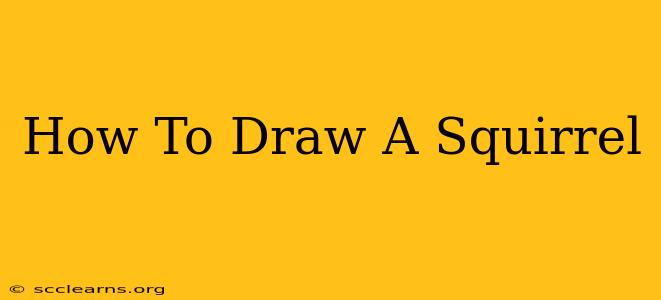Drawing a squirrel might seem daunting, but with a little practice and the right approach, you can create a charming and realistic depiction of this bushy-tailed creature. This guide will walk you through a simple, step-by-step process, perfect for beginners, while offering tips to enhance your skills and add personality to your squirrel drawings.
Gathering Your Supplies
Before we begin, let's gather the necessary materials:
- Paper: Use a paper that's suitable for your chosen drawing medium. Sketch paper or drawing paper works well.
- Pencils: A range of pencils (e.g., HB, 2B, 4B) will allow you to create different levels of shading and detail.
- Eraser: A kneaded eraser is ideal as it allows for precise erasing without damaging the paper.
- Sharpener: Keep your pencils sharp for clean lines.
- Optional: Colored pencils, markers, or paints for adding color and vibrancy to your finished drawing.
Step-by-Step Guide to Drawing a Squirrel
Step 1: The Basic Shapes
Start by sketching light, basic shapes to form the foundation of your squirrel. Think of simple forms like:
- A circle: For the head.
- An oval: For the body.
- Two smaller circles: For the ears.
Don't worry about making them perfect; these are just guidelines. Lightly sketch these shapes, allowing for adjustments as you go.
Step 2: Defining the Body
Connect the head and body ovals with a gently curving line, creating the neck. Add a small, downward-pointing triangle for the nose. Then, sketch two small, almond shapes for the eyes, positioning them above the nose.
Step 3: Adding the Tail
Squirrels are known for their magnificent tails! Sketch a long, fluffy tail using a series of slightly curved lines that taper to a point. Imagine the tail as a series of overlapping "S" shapes for a natural, bushy effect. Experiment with the tail's position – it can be held high, curled, or even draped over the squirrel's back.
Step 4: The Limbs and Paws
Sketch four small, slightly curved lines for the legs. Add small ovals at the ends for the paws. Remember that squirrel paws are relatively small compared to their bodies.
Step 5: Refining the Details
Now it's time to refine your drawing. Add details such as:
- Ears: Define the shape of the ears by adding inner details and fur texture.
- Fur: Use short, light strokes to suggest fur on the body, tail, and head. Pay attention to the direction of the fur growth.
- Claws: Add small claw marks to the paws.
- Whiskers: Don't forget the whiskers! Add a few thin lines extending from the sides of the nose.
- Eyes: Add small, dark pupils to the eyes, giving your squirrel a lively expression.
Step 6: Shading and Texture
Use shading to add depth and dimension to your drawing. Observe how light falls on a real squirrel or a reference image, focusing on the areas where shadows naturally occur. Experiment with different shading techniques to create a sense of texture in the fur.
Tips for Improvement
- Use References: Look at pictures of real squirrels. Observe their posture, features, and fur patterns.
- Practice Regularly: The more you draw, the better you will become.
- Experiment with Different Poses: Draw your squirrel in different actions, such as climbing, eating, or running.
- Don't Be Afraid to Erase: Use your eraser to correct mistakes and refine your lines.
Beyond the Basics: Adding Personality
Once you've mastered the basic techniques, you can begin adding personality to your squirrel drawings. Experiment with different expressions, postures, and even add props to tell a story. Consider adding a nut, a branch, or a mushroom to create a more engaging composition.
By following these steps and practicing regularly, you'll be drawing adorable squirrels in no time! Remember to have fun and let your creativity shine through. Happy drawing!

